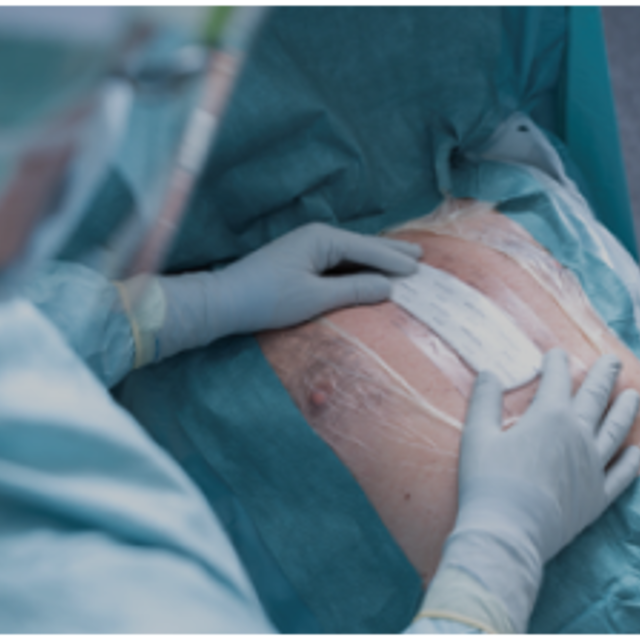Advanced care for low-to-moderate-risk incisions
Discover how Mepilex® Border Post-Op meets the latest expert consensus
Recognise the risks of outdated post-operative dressings.
Tip for healthcare professionals:
Log in to unlock additional clinical articles and resources created specifically for HCPs.
Despite exciting advancements in incision care solutions and paradigms1–4, the same post-operative dressings used five decades ago are still regularly being used5. These dressings are associated with a variety of problems that advanced dressings can often minimise or even prevent, including, but not limited to:
- Surgical site complications6–11
- Frequent dressing changes6,7,12
- Delayed healing13
- Patient pain and discomfort6
- High clinical workload and costs7–9

Learn what types of post-operative dressings experts recommend
To address these and other issues in incision care, consensus meetings were held across the world between 2019 and 2024 including Australia and New Zealand4. The experts discussed key topics and reached broad agreements in two areas:
- The ideal post-operative dressing should possess these six properties4:
- Be flexible, enabling patient movement
- Stay on well
- Be highly absorbent
- Protect the skin from damage, such as blisters
- Be showerproof
- Eliminate dead space between the dressing and the wound
- The post-operative dressing should be changed only when clinically necessary, promoting undisturbed wound healing (UWH)4. This may reduce the risk of surgical site complications, patient discomfort, clinical workloads and costs4,13.
-
International consensus meeting
A summary of findings from the meetings held between 2019 and 2024 to discuss key areas of incision care, including the properties of the ideal post-operative dressing. Find a link to download the Australian consensus document below.
Download a summary of the findings -
Undisturbed wound healing
Focusing on incision care in oncology and orthopaedics, this report summarises the findings from several studies on the efficacy and implementation of undisturbed wound healing (UWH).
Download a report about the benefits of UWH
Talk to our experts
We’re building a community of knowledge to help prevent and manage wounds. Connect with our clinical experts to share insights, learn from real-world experience, and explore solutions that can improve outcomes for patients.
Start your conversation hereAdhere to the expert consensus with Mepilex Border Post-Op
Mepilex Border Post-Op, featuring Safetac® Technology, is our cutting-edge solution for the management of closed incisions with a low to elevated risk of surgical site complications and low to high levels of exudate. Offering up to 14 days of wear time12, it promotes undisturbed wound healing and possesses, with clinical evidence, all six properties of the ideal post-operative dressing as agreed by the experts4,14. As such, Mepilex Border Post-Op embodies the recommendations from the international meetings, enabling you to adhere to expert consensus and provide the latest standard of incision care.

Mepilex Border Post-Op
- Suitable for low-to-elevated-risk incisions with low to high exudate levels
- Features Safetac Technology, minimising damage to the wound and the skin and pain at removal.
- Can be worn for up to 14 days, promoting undisturbed wound healing
- Possesses all six properties of the ideal post-operative dressing as agreed by experts
Learn much more in our Clinical Learning Hub
Covering essential topics for optimal incision care, our Clinical Learning Hub features a growing range of educational materials, from articles and webinars to podcasts and mini-courses.
Visit our Clinical Learning Hub-
References
-
Scalise A, Calamita R, Tartaglione C, Pierangeli M, Bolletta E, Gioacchini M, Gesuita R, Di Benedetto G. Improving wound healing and preventing surgical site complications of closed surgical incisions: a possible role of Incisional Negative Pressure Wound Therapy. A systematic review of the literature. Int Wound J. 2016;13(6):1260–1281. doi: 10.1111/iwj.12492.
-
Rosenbaum AJ, Banerjee S, Rezak KM, Uhl RL. Advances in wound management. J Am Acad Orthop Surg. 2018;26(23):833–843. https://doi.org/10.5435/JAAOS-D-17-00024.
-
Fani N, Moradi M, Zavari R, Parvizpour F, Soltani A, Arabpour Z, Jafarian A. Current advances in wound healing and regenerative medicine. Curr Stem Cell Res Ther. 2024;19(3):277–291.
-
Sandy-Hodgetts K, Morgan-Jones R, Canal A, Leung E, Tan E, Hill A, van Harselaar K. Incision care and dressing selection in surgical wounds: Findings from an international meeting of surgeons from New Zealand. Wounds International. 2024. Available from: https://woundsinternational.com/wp-content/uploads/2024/06/MOL24-Incision-care-NZ-WEB-2.pdf.
-
Queen D, Orsted H, Sanada H, Sussman G. A dressing history. Int Wound J. 2004 Apr;1(1):59–77.
-
Bredow J et al. Evaluation of Absorbent Versus Conventional Wound Dressing. A Randomized Controlled Study in Orthopedic Surgery. Deutsche Arzteblatt International, 2018.
-
Zarghooni K et al. Is the use of modern versus conventional wound dressings warranted after primary knee and hip arthroplasty? Acta Orthopaedica Belgica 2015.
-
Ravenscroft MJ, Harker J, Buch KA. A prospective, randomised, controlled trial comparing wound dressings used in hip and knee surgery: Aquacel and Tegaderm versus Cutiplast. Ann R Coll Surg Engl. 2006;88(1):18–22.
-
Hooper GJ, Rothwell AG, Frampton C, Wyatt MC. Does the use of silver-impregnated dressings reduce the incidence of infection after total hip or knee arthroplasty? A randomized, controlled trial. J Wound Care. 2012;21(4):200–203. Available from: https://pubmed.ncbi.nlm.nih.gov/22584680/
-
Zurcher S, Krapfl L, Burds A. Reducing postoperative surgical site infections in coronary artery bypass graft patients. Poster presented at: WOCN Society 45th Annual Conference; 2013 Jun 22–26; Seattle, WA. Available from: https://us.clinicallearning.com/upload/evidence/Zurcher-2013_Infection-Prevention.pdf
-
Peghetti A. Prevention of post-operative surgical site complications: A quality improvement project. Poster presented at: European Wound Management Association (EWMA); 2018 May 9–11; Krakow, Poland.
-
Van Overschelde P, Sinnaeve F, Lapierre C, Pauwels A, Alam K, Sandy-Hodgetts K. A single-centre retrospective study investigating patient-reported outcomes of extended dressing wear time for incisional healing following orthopaedic surgery: the ARCTIS study. J Wound Care. 2024;33(Suppl 8):S17–26.
-
Wounds International. Undisturbed wound healing: Identifying a new concept in wound care and promoting optimal conditions for post-operative healing. London: Wounds International; 2024. Available from: https://woundsinternational.com/supplements/are-incisions-the-forgotten-wound-rethink-incision-care-to-improve-patient-outcomes/
-
Mölnlycke Health Care. Mepilex Border Post-Op - Instructions For Use. PD-708403 rev. 3. 2024.
-